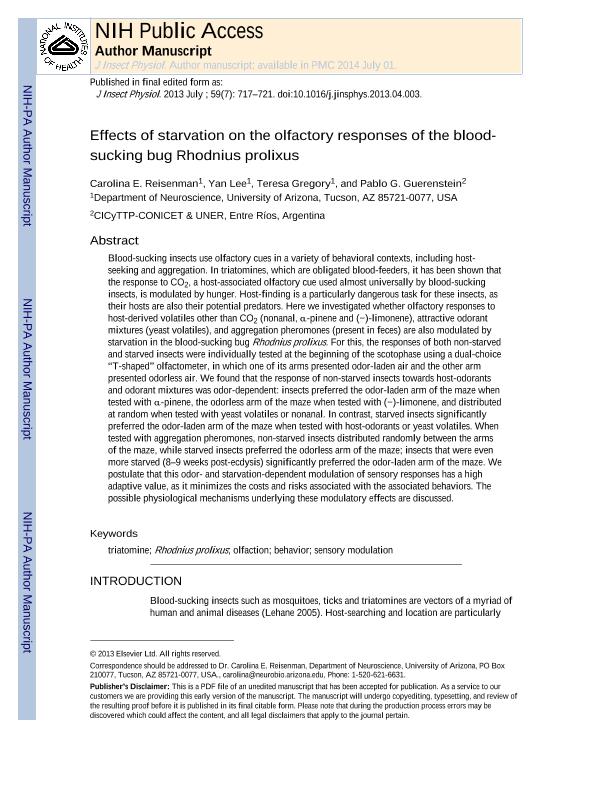Mostrar el registro sencillo del ítem
dc.contributor.author
Reisenman, Carolina Esther

dc.contributor.author
Lee, Yan
dc.contributor.author
Gregory, Teresa
dc.contributor.author
Guerenstein, Pablo Gustavo

dc.date.available
2017-06-23T19:40:54Z
dc.date.issued
2013-07
dc.identifier.citation
Reisenman, Carolina Esther; Lee, Yan; Gregory, Teresa; Guerenstein, Pablo Gustavo; Effects of starvation on the olfactory responses of the blood-sucking bug Rhodnius prolixus; Elsevier; Journal of Insect Physiology; 59; 7; 7-2013; 717-721
dc.identifier.issn
0022-1910
dc.identifier.uri
http://hdl.handle.net/11336/18794
dc.description.abstract
Blood-sucking insects use olfactory cues in a variety of behavioral contexts, including host-seeking and aggregation. In triatomines, which are obligated blood-feeders, it has been shown that the response to CO2, a host-associated olfactory cue used almost universally by blood-sucking insects, is modulated by hunger. Host-finding is a particularly dangerous task for these insects, as their hosts are also their potential predators. Here we investigated whether olfactory responses to host-derived volatiles other than CO2 (nonanal, α-pinene and (−)-limonene), attractive odorant mixtures (yeast volatiles), and aggregation pheromones (present in feces) are also modulated by starvation in the blood-sucking bug Rhodnius prolixus. For this, the responses of both non-starved and starved insects were individually tested at the beginning of the scotophase using a dual-choice “T-shaped” olfactometer, in which one of its arms presented odor-laden air and the other arm presented odorless air. We found that the response of non-starved insects toward host-odorants and odorant mixtures was odor-dependent: insects preferred the odor-laden arm of the maze when tested with α-pinene, the odorless arm of the maze when tested with (−)-limonene, and distributed at random when tested with yeast volatiles or nonanal. In contrast, starved insects significantly preferred the odor-laden arm of the maze when tested with host-odorants or yeast volatiles. When tested with aggregation be, while starved insects preferred the odorless arm of the maze; insects that were even more starved (8–9 weeks post-ecdysis) significantly preferred the odor-laden arm of the maze. We postulate that this odor- and starvation-dependent modulation of sensory responses has a high adaptive value, as it minimizes the costs and risks associated with the associated behaviors. The possible physiological mechanisms underlying these modulatory effects are discussed.
dc.format
application/pdf
dc.language.iso
eng
dc.publisher
Elsevier

dc.rights
info:eu-repo/semantics/openAccess
dc.rights.uri
https://creativecommons.org/licenses/by-nc-nd/2.5/ar/
dc.subject
Triatomine
dc.subject
Rhodnius Prolixus
dc.subject
Olfaction
dc.subject
Behavior
dc.subject
Sensory Modulation
dc.subject.classification
Zoología, Ornitología, Entomología, Etología

dc.subject.classification
Ciencias Biológicas

dc.subject.classification
CIENCIAS NATURALES Y EXACTAS

dc.title
Effects of starvation on the olfactory responses of the blood-sucking bug Rhodnius prolixus
dc.type
info:eu-repo/semantics/article
dc.type
info:ar-repo/semantics/artículo
dc.type
info:eu-repo/semantics/publishedVersion
dc.date.updated
2017-06-23T18:12:37Z
dc.journal.volume
59
dc.journal.number
7
dc.journal.pagination
717-721
dc.journal.pais
Países Bajos

dc.journal.ciudad
Ámsterdam
dc.description.fil
Fil: Reisenman, Carolina Esther. University of Arizona; Estados Unidos
dc.description.fil
Fil: Lee, Yan. University of Arizona; Estados Unidos
dc.description.fil
Fil: Gregory, Teresa. University of Arizona; Estados Unidos
dc.description.fil
Fil: Guerenstein, Pablo Gustavo. Provincia de Entre Ríos. Centro de Investigaciones Científicas y Transferencia de Tecnología a la Producción. Universidad Autónoma de Entre Ríos. Centro de Investigaciones Científicas y Transferencia de Tecnología a la Producción. Consejo Nacional de Investigaciones Científicas y Técnicas. Centro Científico Tecnológico Conicet - Santa Fe. Centro de Investigaciones Científicas y Transferencia de Tecnología a la Producción; Argentina. Universidad Nacional de Entre Ríos; Argentina
dc.journal.title
Journal of Insect Physiology

dc.relation.alternativeid
info:eu-repo/semantics/altIdentifier/doi/http://dx.doi.org/10.1016/j.jinsphys.2013.04.003
dc.relation.alternativeid
info:eu-repo/semantics/altIdentifier/url/http://www.sciencedirect.com/science/article/pii/S0022191013000954
dc.relation.alternativeid
info:eu-repo/semantics/altIdentifier/url/https://www.ncbi.nlm.nih.gov/pmc/articles/PMC3681923/
Archivos asociados
